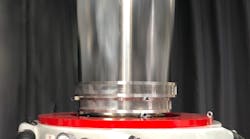In a single step, Gneuss’ new MRSjump extruder recycles post-consumer PET from thermoformed trays directly into sheet for making new trays.
The MRSjump extruder allows processors to skip drying PET regrind prior to recycling and eliminates the need to pelletize it.
In addition, the process is appropriate for food-contact applications, according to Gneuss.
Currently, PET tray manufacturers make extensive use of bottle flake. However, the supply of this feedstock will decrease as it increasingly is made into new bottles as part of a worldwide emphasis on creating a circular economy.
“Everybody wants those PET bottle flakes, but people are looking for more material, so people are becoming more interested in these PET trays,” said Monika Gneuss, VP of sales and marketing manager of Gneuss.
Numerous challenges have hampered efforts in this area. The intrinsic viscosity (IV) of the regrind is too low to permit direct recycling on a conventional sheet extrusion line, Gneuss said. In addition, unlike bottle flake, the regrind is contaminated with other polymers due to coextruded or laminated layers.
PET destined for food contact must be processed in a way that efficiently decontaminates the polymer but is gentle enough to preserve its mechanical properties.
The MRSjump incorporates technology used in previous Gneuss MRS (multi-rotational system) extruders that recycle PET for sheet, fiber and repelletizing. The technology, available for more than a decade, processes highly contaminated materials without pre-drying.
The MRS is based on a conventional single-screw extruder, but also has a multi-rotation section with satellite screws that are driven by a ring gear and pinion transmission. Consequently, its devolatilization capacity is more than 50 times greater than a single-screw extruder.
The MRSjump has a similar but modified and longer multiple-screw section that increases the material’s residence time while reducing shear. By keeping thermal and mechanical stress on the material low, the resin retains excellent mechanical and optical properties, Gneuss said.
While the original MRS features a vacuum system of 25 to 50 millibars, the MRSjump features a deeper (more powerful) vacuum system, below 10 millibars. The deeper vacuum on the MRSjump boosts the resin’s viscosity. It means processors can skip the step of boosting IV through solid-state polymerization or liquid-state polymerization.
The degassing efficiency of the MRSjump extruder makes it possible to comply with FDA standards without time-consuming and cost-intensive upstream or downstream material treatment, the company said.
“We’re trying to build viscosity, so the challenge is to get out the water, the volatiles, and then find a way to have those polyester chains rebuild while at the same time not shearing the material or ruining it in some other way,” Monika Gneuss said. “There have been lots of different challenges along the way.”
Bruce Geiselman, senior staff reporter
Gneuss Inc., Matthews, N.C., 704-841-7251, www.gneuss.com






